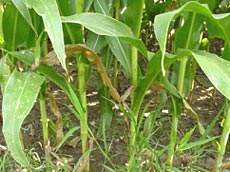|
Features,
Honors
& Awards, Ag
Announcements
Ag News Elsewhere
(fresh daily from the Web)
|
|
Features
|
|
Central
Illinois Ag announces field days
[AUG.
14, 2001] Whenís
the last time you got a chance to go to a real ag equipment field
day sponsored by a local dealer? Remember? Equipment shows in a
neighborís field, a complete lineup of shiny new models ready for
you to climb in and drive, tillage demonstrations, maybe an ag
personality you might bump into, easy parking, a short drive from
home ó and it was all free?
|
|
Central
Illinois Ag is hosting a pair of these "old style" field
days during the fourth week of August. The events will be Wednesday,
Aug 22, north of Havana, and Friday, Aug. 24, south of Pekin.
Demonstrations begin at 9 a.m. and end at 3 p.m. both days.
Mark
McLaren, show coordinator recalls, "Most of us remember that
sense of awe or excitement we felt when we saw that first new
combine or tractor ó maybe at the fair, maybe being delivered to
the neighbors or at the dealers."
"Farmers
in the Atlanta, Farmer City and Clinton areas have known us for
generations," says Steve Schmidt, president of Central Illinois
Ag. "At Pekin, weíre still the new kid. We chose the Pekin
area for the events so farmers in that area could get to better know
us and what we have to offer."
According
to Schmidt, Central Illinois Ag has grown dramatically in the past
year. The company is the result of the merger of George H. Dunn,
Inc. and Schmidt-Marcotte.
Those
who plan to attend the field days are asked to call (800) 762-2325
by Aug 17. Your RSVP will help in planning the noon meal. Those who
would benefit from attending the events include farmers and agri-business
people.
Visit
the Central Illinois Ag website at www.centralilag.com
or call 1 (800) 762-2325 for more information.
[News
release]
|


|
|

|
|
|
Whatís
making those holes?
By John
Fulton
[AUG.
13, 2001] The
past two weeks have created holes everywhere. They exist in yards
and tree leaves. Of course we have been "run over" by
anthracnose creating holes in tree leaves for a few months, but
these holes are caused by insects.
|
|
There
are huge numbers of defoliators (things that eat leaves) working on
just about every kind of tree leaf that is left on the tree at this
time. Telltale signs that you might have this occurring would
include tree nests, stripped leaves (often leaving the vein of the
leaf) and the many droppings from what were once your leaves.

We
have had large numbers of caterpillars throughout the spring and
summer. Conditions must have been right. The ones eating tree leaves
include walnut caterpillars, eastern tent caterpillars, tussock moth
larvae and fall webworms. This is just to name the more prominent
ones. In this grouping, the ones that are easy to single out are the
fall webworms. They expand their nest and continue to feed inside
the webbing. The others leave a nest or cocoon and feed on leaves
individually or in groups. Most noticeable are the eastern tent
caterpillars that tend to work on a branch at a time and do it as a
group.
The
question most often asked is, "Will they kill my trees?"
and the answer is, "Probably not." If we think about it, these
insects exist every year in wooded areas, and very few of the trees
die. If youíve ever been to Wildlife Prairie Park during a bad
year, you can really appreciate the numbers of the eastern tent
caterpillars you can come in contact with in a short period of time.
Yet, those trees do come back year after year.

If
you canít stand the sight of the caterpillars, donít want to
look at naked trees any earlier than you have to, or want to get
even with the larvae of the Lepidoptera order, you can control them
to a certain extent. Most insecticides will provide control of the
larvae. Insecticides included would be Sevin, diazinon, Orthene,
Dursban, and B.t. as an organic control. For fall webworm, you can
also clip off the nest area and burn it.
[to top of second column in
this article]
|

The
other types of holes that I referred to are in the ground. Some are
exit holes (such as for cicadas) while others are entrance holes (as
in June bugs and cicada killer wasps). Recently, both groups have
been active. The cicadas can be heard regularly now. The wasp is a
very formidable-looking insect approaching two inches long, but it
is a relatively timid wasp that is not easily provoked. You will
have to weigh the benefits of the wasp against the risk of getting
stung. The wasp is actually killing the cicada, burying it and then
laying eggs in it. A drench of liquid diazinon in the hole area or a
general grub treatment would control the wasp.

That
brings me to grubs. June bug, Japanese beetle and green June bug
numbers have been very high in some areas. First places to check for
grubs would be along walks, driveways and patios, as well as under
security lights. If youíve kept your yard lush with water, youíll
probably get more than your share of grubs. The beetles lay their
eggs in the best-looking grass. Green June bugs are a little
different. They tend to lay their eggs in organic matter such as
gardens and flower beds. The treatment is best done with granular
products of diazinon or Grubex.
[John
Fulton]

|
|

|
|
|
Seven
4-H members win scholarships
[AUG.
10, 2001] College
scholarships were presented to seven Logan County 4-H members at the
Logan County Fair last week.
Matt
Duckworth, a graduate of Hartsburg-
Emden High School, won the $500 scholarship presented in memory of
W.G. Colburn. The late Mr. Colburn had been on the fair board for
about 45 years and was president of the board about 36 years,
according to nephew Warren Fink. W.G. Colburn was the son of
Charlie Colburn, one of the original organizers of the Logan
County Fair. Matt will be in the pre-veterinarian program at the
University of Illinois.
Four
scholarships, two for $750 and two for $500, were presented by the
Logan County 4-H Foundation. A scholarship for $750 went to John
Davison of Beason. John will attend the University of Illinois
this fall.
Another
$750 scholarship went to Jackie Bakker of Lincoln, who will also
attend the University of Illinois.
A
$500 scholarship was presented to Zac Tibbs of Middletown, who
will attend Southern Illinois University at Edwardsville. A $500
scholarship also went to Betsy Bakker of Lincoln.
A $500 college
scholarship given by Graue Inc. went to Sarah Conklen of New
Holland, and another $500 scholarship, presented by Xamis
Ford-Lincoln-Mercury, was given to Andrea Martinie of Middletown.
[Joan
Crabb]
|
|
|
Click
here for links to Logan County Fair information.
|
|
|
Logan
County crops ó a varied picture
[JULY
26, 2001] Logan
County has become a varied picture in agriculture over the past few
weeks. With critical timing from the first week of July to date for
corn, much-needed rainfall fell in some areas. Other areas were
virtually shut out. Pictured below is an ear of corn with poor
pollination due to heat stress at a critical time.
|
|

Also
noticeable in area cornfields was the firing of lower leaves due to
the heat and moisture stress, as plants protected themselves and
continued filling kernels on the ear.

Insect
damage was also seen, with rootworm beetles causing some silk
clipping and corn borers riddling some stalks.


Soybeans
have a critical point approaching as they start the pod-fill period.
They continue to bloom, set pods and begin to make the seeds grow.

[to top of second column in
this article]
|
Many
insects, such as bean leaf beetles and grasshoppers, have caused
some minor defoliation in the soybean leaves.

For
the horticulturalist in us, we have seen the wilt virus transmitted
by beetles in the cucurbits, such as pumpkins and cucumbers.

And
lastly we have a problem we can take care of. That is damage by
potato leafhoppers. It is indicated by a brown or black
"V" at the tip of leaves. A simple spray treatment of
diazinon or carbaryl will prevent further damage. This picture
happens to be a rose.

Not
all is bad, but it does make for some more dramatic pictures. If
weather could be custom-ordered, it would involve about an inch of
rain a week (and more than a tenth or two at a time would be nice),
high temperatures of about 85 degrees and lots of sun.
The
next items coming to Lincoln Daily News from the Extension
office will be fair photos. The Logan County Fair will officially
open on July 31 and will run through Aug. 5. The 4-H shows have
already begun, with foods and clothing exhibited before the fair.
Dogs will show on the Saturday before the fair, and most project
divisions will be shown on the Monday before the fair. Hope to see
you there!
[John
Fulton]
|
|
|
New
techniques keep streams
from carrying away farmland
[JULY
24, 2001] "Ninety-three
percent of Logan County is farmland, and 97 percent of that farmland
is prime land ó
thatís as good as you get," says Bill
Dickerson. Preserving that prime black soil is a high priority for a
group of local and national organizations.
[Click
here for more photos]
|
|
A
field day sponsored recently by the Logan County Soil and Water
Conservation District and the Land of Lincoln Soil Savers gave area
farmers a look at a new stream stabilization technique, one way to
control soil erosion. These two groups, along with the U.S.
Department of Agriculture Natural Resources Conservation Service and
the Illinois Department of Agriculture are working on projects to
prevent Logan Countyís waterways from carrying away its farmland.
"With
three good-sized creeks in the county ó
Salt, Kickapoo and Sugar Creeks ó
itís a never-ending job," Dickerson says. As
a district conservationist for the NRCS, Dickerson works closely
with Logan Countyís Soil and Water Conservation District.
On
Thursday he took a group of area farmers to a Kickapoo Creek site
southeast of Atlanta, on farm ground owned by Dave Evans and Dan
Koons, to explain a new technique called the stream barb system.

[These
three rock projections are a new stream stabilization technique
called barbs. Pointing
upstream, they work together to redirect the water in Kickapoo Creek
toward the middle of the creek and keep it from undercutting the
stream bank.]
What
the farmers saw were three projections of large stone riprap jutting
out into the creek, angling upstream, at a point where the creek had
been cutting away the bank. The barb-shaped stone projections work
together to catch the current and redirect it to the middle of the
stream, away from the bank which is being eroded.
The
project was completed in December of last year, and, according to
the landowners, is working just as predicted.
"A
few weeks ago, when the water was higher, I could see it working. I
could actually see water turn and go back into the channel,"
Koons said.
Before
the barbs were put in, he added, the bank went straight down,
because it was being undercut by the creek at the rate of at least a
foot a year. Now the stream bank slopes, maintaining the angle it
was given by the construction crew that put in the new stabilization
system. The bank is also being held in place by the natural
vegetation that is beginning to grow there.
The
new stream barb system is protecting about 600 feet of the bank of
Kickapoo Creek, Dickerson says, preventing the loss of about
one-half ton of soil per foot per year. That means 300 tons of prime
topsoil is no longer washing down the creek, eventually ending up
somewhere in the Gulf of Mexico.
It is
the nature of streams and rivers to meander, traveling in a series
of S-curves, as they slow down and broaden out their flood plains,
Dickerson explains. Formerly, engineers tried to keep streams from
eroding the land around them by straightening them out, a process
called channelizing. Kickapoo Creek was channelized on the Koons-Evans
farm in the mid-1970s, when the land belonged to a different owner.
But
the channelizing couldnít prevent the creek from reverting to its
natural tendency to meander, and it soon began cutting into the land
again. (Itís now against federal law to straighten a stream.)
Today
the idea is to work with nature, allowing the stream to meander but
preventing it from meandering too much, Dickerson explains.
"Moving water is one of the strongest forces on earth. We are
now going with the natural force of the stream, rather than fighting
it."
[to top of second column in
this article]
|
Although
itís the newest technique, the stream barb system on the Koons-Evans
farm isnít the only system on Kickapoo Creek that is keeping Logan
County soil in Logan County. Two different projects upstream, called
bendway weirs and similar to the barb system, are on land owned by
Rodney Alberts and Jerry Cisco. They were also installed with the
help of Dickerson and the Soil and Water Conservation District.
These
stream stabilization systems not only save soil, they also
contribute to better water quality. They prevent streams from
filling up with sediment and also prevent agricultural chemicals and
nutrients from draining into waterways. Dickerson says the weirs and
barbs are also good for wildlife. A degrading stream is sterile,
providing little or no natural habitat. Rock bars, however, make
good aquatic habitats, places for fish to hide or breed.
Dickerson
explained the process of constructing the stream barb system to the
group of about 30 farmers who came to the site, pointing out that
the average cost of installing such a system on a Logan County farm
would be about $11,000. However, the Illinois Department of
Agriculture has a $1 million program in place this fiscal year (July
1, 2001 to June 30, 2002) to help fund stream stabilization, and
farmers who put in an approved system can get as much as 75 percent
of the cost reimbursed.
Several
construction firms in the area do the work, Dickerson said, and the
NRCS is ready to help farmers do the paperwork. A steam
stabilization project usually takes about a year from start to
finish because of the permits required -- from the U.S. Army Corps
of Engineers, the Illinois Environmental Protection Agency and the
Illinois Department of Natural Resources.
The
NRCS has been doing stream stabilization projects for the past 10
years, along with a number of other conservation programs. These
include no-till farming, which according to Dickerson has
contributed more to soil erosion control than any other program, and
the Conservation Reserve Program, the USDAís most popular
conservation program. CRP allows landowners to take cropland out of
production for as much as 15 years, getting payments of as high as
$192 an acre for the idle land. The land can be put in grass for
erosion control or planted with trees. Most land in CRP is already
environmentally sensitive, Dickerson says, often located on a flood
plain or on sloping ground.
After
viewing the stream barb system, the farmers adjourned to the Atlanta
Park shelter, where they heard a program by Howard Brown, agronomist
with Growmark of Bloomington. Brown walks the fields, looks at crops
for indications of insects, fungus and other plant diseases, and
gives farmers an update on how the season is progressing and what to
look for when making decisions for next yearís planting.
Brown
said the yield potential for area crops this year looks good
"if the weather is good from here on out."
Anyone interested in more
information about stream stabilization or other conservation
practices may call the Soil and Water Conservation District office
at (217) 732-2010, Ext. 3.
[Joan
Crabb]
|
|
|
Honors
& Awards
|
|